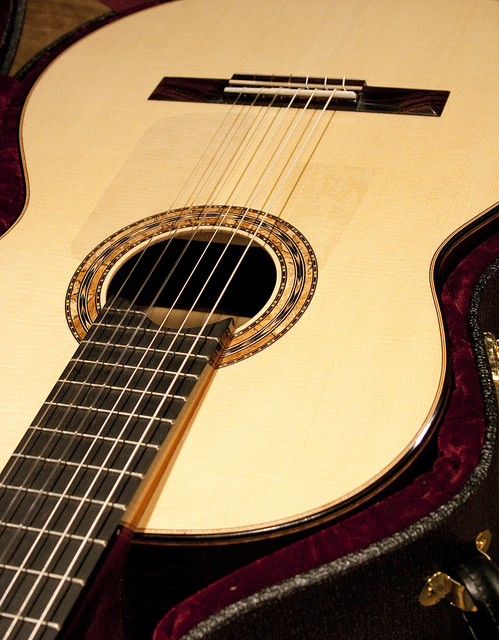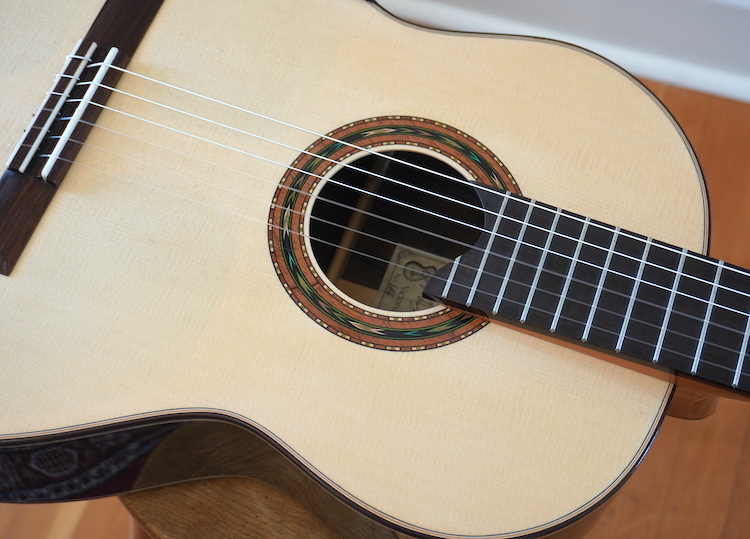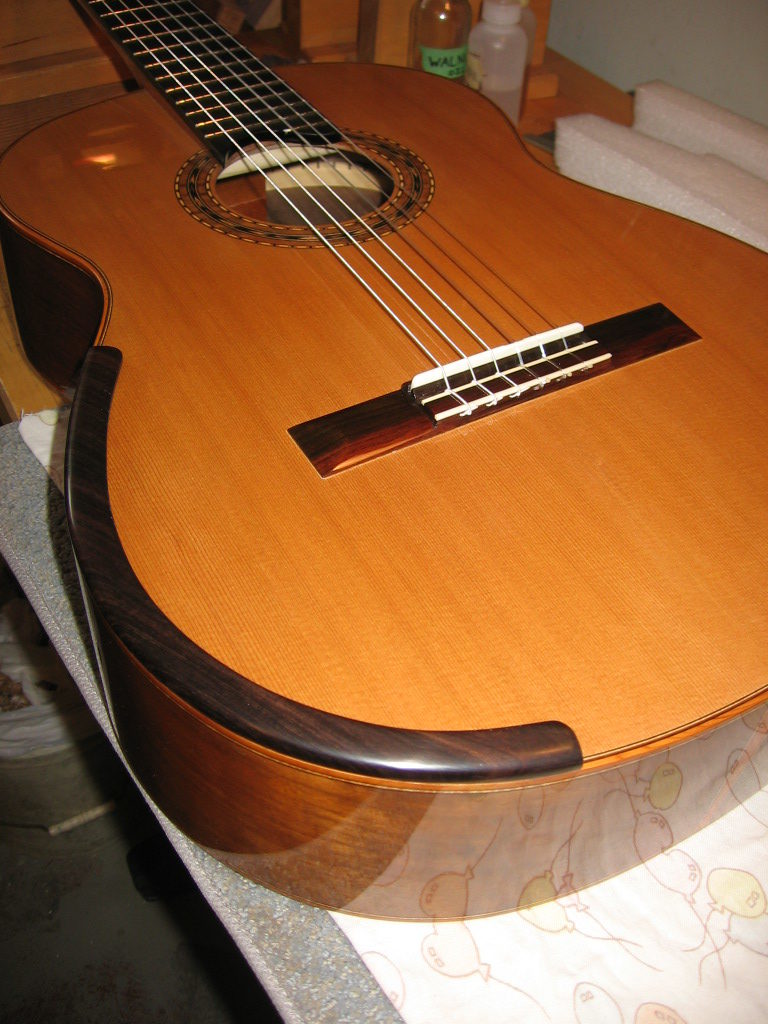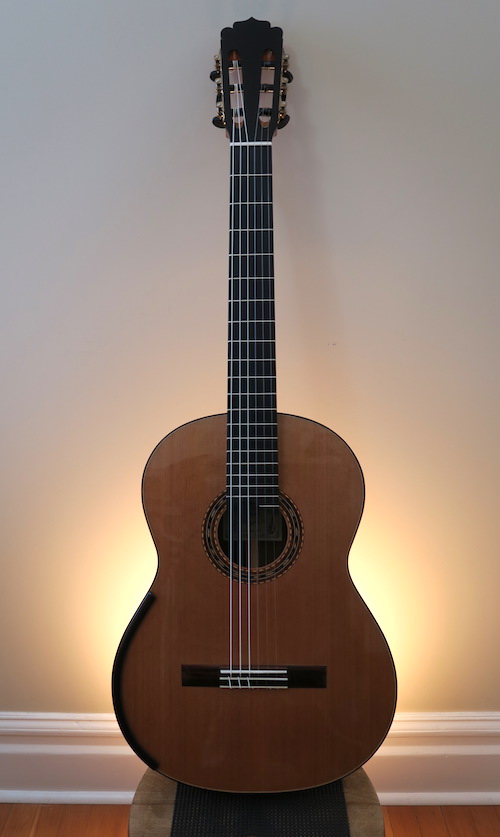
Also see this page: Classical Guitars for Sale and Recommend Factory Guitars
Since I’m a player and not a luthier I will fill out this article with quotes from reputable luthiers and guitarists. Sometimes these quotes can be out of context so make sure to follow the links to their websites.
A word of caution regarding tonewoods & design:
Woods and design affect each other mutually. So, if I generalize that cedar is fuller sounding than spruce, this is not necessarily true. The wood is affected by the design the luthier has used or created. Also, what constitutes the sound warm or full anyway? Play the guitars of a luthier to hear what sound will result from what woods and design. Don’t forget that there are good and bad cuts of wood so a bad cut of expensive European spruce might not sound good at all. We can talk endlessly about woods but I think it’s the luthier and design that is far more important. Everything you think is true about guitar woods or design can be proven wrong or enhanced by a skilled luthier.
Check out this nice summary via Siccas Guitars YoutubeSiccas Guitars Youtube.
Some generalizations about spruce & cedar soundboards:
Guitar Salon – The differences between cedar and spruce: The most noticeable and most obvious difference is in appearance. Spruce is light blonde in color, almost sometimes with a honey/amber tint, while cedar is darker and appears in various shades of brown. Cedar bears a distinct, pleasant odor and is slightly more porous, which may contribute to a faster responding sound. However, there are many more factors that contribute to the overall sound of the guitar. These include internal structure, thickness of material, pattern and shape of the instrument, type of finish, and type of strings. Spruce is the traditional wood that was used for centuries of guitar making. Cedar is much newer on the scene, having become popular and widespread in its use, starting in the mid-1960’s. Link/Source: Guitar Salon International FAQ
Marcus Dominelli on whether spruce guitars project better: When comparing spruce and cedar guitars, built in a traditional fashion I totally agree that spruce guitars tend to project better to the back of the hall. In my listening experience, they are more articulate, and have better separation of notes, most of the time. But once you get into other modes of construction, like lattices and double tops, the game changes, and it’s harder to compare the characteristics of the two woods. Link/Source: Marcus Dominelli via Delcamp
Bradford’s generalization of the sound of spruce: I find that spruce has a very direct sound with a golden bell-like sound. It is maybe a bit more clear, balanced, and sometimes has more sustain. I currently own a spruce because I wanted the best possible tone, projection, and balance. I do sometimes miss the full-bodied sound and perceived (?) ‘near-the-player-volume’ of my previous cedar top. However, how do we measure volume, through loudness or projection? In general, I rarely consider spruce guitars to be ‘loud’ guitars. Instead I think of them as projecting the sound clearly in line to the back of the hall whereas cedar fills the hall with sound.
Bradford’s generalization of the sound of cedar: I find cedar guitars to be warmer, darker, and fuller sounding than spruce guitars. Maybe they don’t project as directly or clearly but can fill a room with lots of sound. They are generally easier to play, that is, more responsive (due to their light weight). I always recommend that my students get cedars because that full bodied sound can cover up a lot of what would otherwise be poor tone or messy playing. Cedar is forgiving of student technique. I’m not saying that it is lesser quality, however, just different. I simply find that spruce guitars require that I play with more precision in order to get my desired sound. Both are great in the hands of professionals but if you’re a student I’d recommend cedar.
Is this True? I’ve heard spruce guitars that sound like cedar and cedar ones that sound like spruce. I lie not! So, remember that these are generalizations at best. Also, don’t forget that the backwood and bracing wood change the sound too! So you can end up with all sorts of combinations of sound.
In perspective – luthier quotes:
Eric Monrad on topwoods:
I build soundboards with both spruce (European and American) and cedar. I appreciate the unique qualities of each wood, and the choice depends on the player’s preference. Link/Source: Monrad Guitars
Marcus Dominelli on Spruce & Cedar: It’s possible to generalize between spruce and cedar if you’re comparing them built in the same style, for example, fan braced cedar to fan braced spruce. But just don’t start comparing a spruce fan braced to cedar lattice, or a cedar double top!! I think it’s pretty well agreed upon that spruce tends to sound a bit crisper, with better separation and definition. Cedar tends to be warmer and darker in sound quality. But I’m continually told that in blind tests most people cannot tell them apart!! So I think we sometimes hear what we expect hear. In the end a good guitar is a good guitar, regardless of the woods used. Link/Source: Dominelli on Delcamp
Gregory Byers on Spruce or Cedar? “It has been my observation that players who are used to spruce find it more to their liking; and those used to cedar prefer it. Part of this seems to have to do with the sound we expect to produce. Part seems to be that different techniques are required to obtain the best sound from each. It often takes some time to adapt the appropriate right hand follow-through to compliment each wood. There is a tactile difference here, perhaps related to the generally quicker development of the note in cedar. Beyond this, the sonic differences are subtle. For many players it is not hard to feel the difference but as a listener it is easy to be fooled. In general, spruce is clearer, yet with a denser, more complex sound and longer sustain. Cedar is “punchier”, often with more headroom and is sometimes described as “darker”. It may seem louder to the player but in large halls spruce often carries better, perhaps because of its clarity. Spruce is usually more colorful. These distinctions are subtle and not always apparent. Both woods can make great guitars. I personally tend to prefer European spruce, but North American spruces, particularly Adirondack and Engelmann, can be very attractive. Likewise, coast redwood and Port Orford cedar can make excellent guitars.” Link/Source: Byers Guitars
Video: Miles Roberts on Spruce vs Cedar
Video Source/Link: Miles Roberts on Youtube
Types of Cedar & Spruce Tonewoods
Since I’m not an expert on woods or a luthier please feel free to leave a comment and correct me. However, I’ve tried to use information that I’ve seen listed in multiple places so as a generalization I’m hopefully correct.
European Spruce or German Spruce: Considered one of the best tonewoods of all, at least, traditionally speaking. However, poor availability of high grade cuts means that you might be better off going to an alternative with a high quality cut. Compared to engelmann, euro spruce has the same full tonal palette but maybe with a quicker response. Both are prized for their colour and stiff lightweight.
Traphagen on European Spruce: “Clear bell-like sound with a full tonal color pallet. With age and playing, the guitar becomes warm and rich. To me, European Spruce produces the most sophisticated tonal range of all the top woods.” via Traphagen Guitars
Engelmann Spruce: A white creamy coloured wood that is softer than sitka. Generally a bit more mellow sounding than euro or sitka possibly due to being slightly less stiff. Although engelmann logs are generally smaller but there still seems to be high quality cuts out there. Northern BC (Canada) luthiers are likely bless due to their close proximity to dealers. I have a engelmann spruce and it has a wonderful tone, however, it might not have the quick response and clarity of a euro.
Sitka Spruce: Sitka is the standard wood for steel-string guitars. This is partially due to it wide availability, large diameter logs and high yield. Therefore, it is available in high grades despite the quantity used. It is also used in classical guitars. It is generally stiffer and heavier than the rest of the spruce varieties. This makes sense that it could handle to high pressure and intensity of steel-string guitars. I have heard, however, that sitka also makes excellent classical guitars if the design matches the wood properly and if one can find a decent lightweight cut or braces lightly.
Lutz Spruce: Lutz spruce is a hybrid wood and appears to have much potential.
Dominelli on Lutz Spruce: “The thing that I like about Lutz spruce is this: It has the stiffness of Sitka spruce, with the light weight of Engelman spruce. This is the dynamo combination as far as I’m concerned. Of course, not all Lutz is going to be great wood; you can never make absolute statements about a species of wood. I love engelman spruce too. My only problem with engelman is that it is often very soft, and run-out is more common in engelman than sitka. Lutz spruce is probably the closest thing to fine German spruce I have seen, except that Lutz is a bit cheaper. I can’t say that it’s more available than European spruce because so few people are cutting Lutz spruce for guitars.” via Delcamp Forum
Other spruces: I’ll have to update this when I get some comments and more. But please let me know about Italian Spruce, Adirondack Spruce, etc..
Western Red Cedar: These large diameter trees can produce excellent cuts with straight grains. The wood is generally stiff and lightweight making it great for classical guitar tops.
Other cedars: Today, it seems that Western Red Cedar is used most often. However, other options include: Alaskan Yellow Cedar (I believe this is also called Canadian Cypress), Port Orford Cedar, Spanish Cedar, Coastal Redwood (?). My understanding of Spanish Cedar is that it is from central and south America but I know little more.
Luthiers and players, help out this conversation
Please leave a comment below.





Have always been drawn to the rich darker sound od cedar, but lately have been drawn to redwood ,still warm , rich but more high end sparkle, may all be in my head ?.
Is it readily available and good to work with? What’s the reason it’s not used more often I wonder?
I just bought an Hanika Natural PC (Cedar). Since I had a less expensive cedar one for many years, I was looking for a spruce one for a change. But the cedar one I tried had more projection and a tone quite close the the Natural PF (spruce). It is quite light weight and dark brown.
It is well known that cedar fences last longer than spruce fences. Cedar may be less prone to warping bc its oils sustain its structural integrity during dry conditions, a situation that’s akin to “fracking” where the earth surface integrity is compromised.
Spanish cedar (Honduras cedar, cedrela). Not (usually) a topwood, it isn’t even a softwood. It’s actually a cousin of mahogany, and has long been a preferred wood for classical necks (as well as cigar boxes).
“Cedar” is one of those names which has long been used for a large number of completely unrelated trees. There are only three true cedar (cedrus) species: Lebanon cedar from the mideast, Atlas cedar from North Africa, and a very rare Chinese species. Western red “cedar” is actually an arborvita; Port Orford “cedar”/Alaskan yellow “cypress” is neither, but rather a “false cypress” (chamaecyparis). Eastern red cedar, familiar from cedar chests and closets, is really a juniper.
I have played classical guitar for 15 years, and built them for 4 years (I consider myself a beginner on that area). And I have played, built and hear pretty good guitars made of different woods (top, back and sides and bracings). I agree that, even when the top is the main sound provider, all the other materials, designs and building techniques, play a big roll on the quality/type of the final resulting sound. That being said, my conclusion is that the sound is very subjective and the decision whether to choose from a spruce or a cedar guitar is frequently influenced by many factors like: “what wood is my teacher’s guitar made of?”, “what wood was the first guitar it amazed me made of?”, “what is the sound I am conformable and pleased with”, “what sound I am looking for”. The only thing that could not be ever subjective about guitars is the volume and the projection (which it is also a factor that influences when choosing a guitar). Every person is different and there is a guitar for each person.
I’m not a luthier and in no way an expert, infact I’ve been playing purly acoustic for 20+ years .I bought a simon and patric songsmith a year ago in toronto (there built in la patrie quebec ) so I assume it would have canadien spruce , just bought the s&p cedar woodland both are over 12 years old so just getting mature both wild cherry back n sids. the cedar is very tonal thin almost tinny but has steel strings prob of not good quality , my spruce has nickle bronze and it ,, for the moment blows the cedar away for deep rich sound with very pleasing ring out almost bell like , there exactly opposite what I expected , however the cedar has issues 1, nasty strings 2, only having it 3 hours It feels and sounds very dehighdrated so unfare comparison even the bridge and neck I see are little high so once I tech the cedar I’m sure it will have a far more pleasing dark sound , just wanted to say strings, highdration, setup, I feel certain blind testing most people would guess spruce was cedar and vice verse , so I think I agree with the experts lots of factors ,,, I susspect my post is redundant ha ha
.ive played both spruce and cedar .i like the cedar for its full deep, rich sound. spruce is a fine top as well i guess its what you are looking for in your own style one thing i can tell for sure ,is that the type of string you are choosing. i do not go cheap on my strings , i find this also provide a better sound with both the cadar and the spruce. i guess its the old saying you get what you pay for .in both types of guitars . thank you thom.
Nice collection of information. I agree with the general description of both. I bought an expensive Cedar top. I would of bought a Spruce if one of those guitars was available. I like both.
Spruce and cedar tops seem to be the standard, although I have googled and come across a luthier in Paraguay that uses Walnut and various Maples for some of his tops. What is your opinion of the sound emanating from guitars that have such unusual woods for the top? I would think tops made of hardwoods would not resonate very well. His guitars certainly are beautiful in appearance.
I don’t know much about it Gord but certainly light and stiff woods seem to be the go-to woods for tops so one it can be thin enough for response and stiff enough for structural and sound qualities. My understanding of wood like maple is that it dampens the sound, thus its use in bowed instruments. I bet you can find an answer on delcamp or some forum…
Check out this one on delcamp:
http://www.classicalguitardelcamp.com/viewtopic.php?f=11&t=75703&start=0
Having built several guitars, owning guitars of various woods and after playing many, others, I find it hard to pick a favorite wood. As far as my own building, my guitars with California Redwood tops have been the most successful. Several players have commented on their balance and richness of overtones. As a result, I am really enjoying building with Redwood and will continue with it. It also helps that I have a private source of excellent 100 yr. old Redwood! On the other end of the spectrum, Sitka Spruce has been a problem for me, with trebles that ring but dull mid-range and bass. I have played others’ Sitka instruments that are much better sounding than mine but never really great. But between Cedar(s) and Spruce(s)… lots of overlap and lots of fine-sounding instruments out there!
You can brace a Sitka spruce top with very lightly while tucking all, and I mean all braces. I have to be that this creates a lingering bass to ring under the normally long sustains of the treble. Sitka also goes through drastic change over time relative to red spruce or cedar. Sitka can benefit from a less dense back/side pairing ie; mahogany over dalbergia.